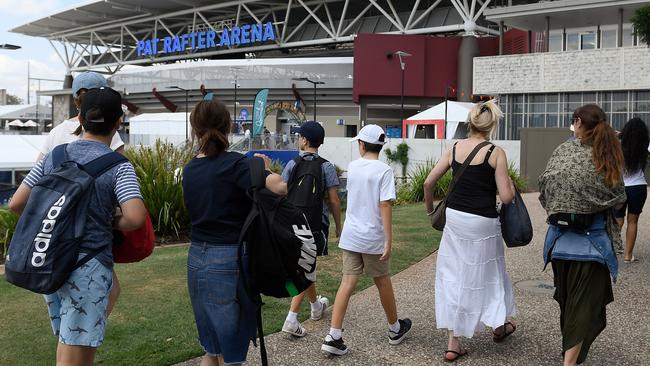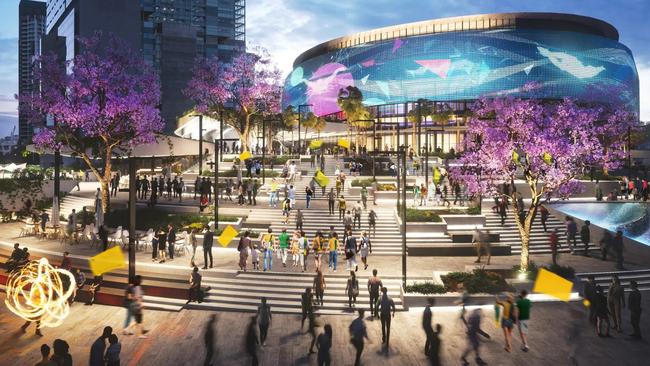Editorial: It’s not either/or... tennis can’t come at the expense of the Brisbane arena
The state government cannot afford to get itself in an either/or scenario that puts genuine legacy projects like the Brisbane Arena at risk, writes The Editor.

Opinion
Don't miss out on the headlines from Opinion. Followed categories will be added to My News.
Brisbane is a capital city hosting the biggest sporting event in the world – so the hard truth is – it’s going to cost a lot of money.
The $113m price tag to upgrade the Pat Rafter Arena to Olympic standard so we don’t lose the tennis to Melbourne in 2032 will be money well spent when some of the biggest sporting superstars in the world start rolling into Tennyson.
It would also cement the Brisbane International, which has only just got back on its feet after the pandemic, as a world-class event and ensure its future for decades to come.
What the state government cannot afford however is to get itself in an either/or scenario.
The money needed for smaller venues to be lifted to Olympic standard cannot come at the cost of genuine legacy projects like the Brisbane Arena.
The hard work to get an inner-city arena off the ground began in 2007 – well before any Olympic bids – because it was widely recognised that it was desperately needed to elevate Brisbane’s status to be a true global city.
That need has not changed.
In fact, the 2032 Olympic and Paralympic Games makes it even more critical.

Over the years, both sides of government have supported the concept but have sadly failed to get it off the ground.
The Boondall Entertainment Centre has served its purpose well, and for a 40-year-old venue it’s still in relatively good shape.
But every other major city in the world has an inner-city venue – able to host around 20,000 people.
Why? Because then fans attending concerts and shows can spend cash in CBD restaurants and bars before and after events – and have more transport options to get home.
It just makes sense.
Which is why if the state government’s venues review team recommends both a new stadium at Victoria Park and an inner-city indoor arena, that advice must be accepted.
The venues review team’s report is now in Deputy Premier Jarrod Bleijie’s hands, and will be publicly revealed on March 25 at The Courier-Mail’s Future Brisbane event, as will the government’s plan.
Mr Bleijie and Premier David Crisafulli cannot make the same mistake former premier Steven Miles made when he ignored his own independent report’s recommendation to build a new $3.4bn stadium at Victoria Park.
The alternative – an upgrade of the QEII stadium at Nathan – was widely panned, and rightly so.
The Crisafulli government risks the same fate.
The previous government was crippled by indecision. This government seems fixated on its immediate political future rather than the best interests of the city and creating a tangible legacy from the opportunity we have been given to host the 2032 Games.
It seems caught up in not breaking election promises that should never have been made (no new stadiums comes to mind).
But there was another promise the Premier made at The Courier-Mail’s Future Brisbane event in November: “Let’s let the experts decide, not the politicians”.
Legacy must extend beyond any one sport and while losing the tennis to Melbourne Park would be embarrassing, failing to build a legacy-defining inner-city arena would be a travesty and right up there with the previous government’s QEII disaster.
Lifesaving inhaler must not be lost to us
Queensland excels in medical invention and, yet again, the Sunshine State appears to have thrown up a new idea which could change the lives of millions of people with deadly allergies.
A revolutionary inhaler to treat anaphylaxis is being developed by Brisbane-based medical technology company De Motu Cordis Pty Ltd, and it’s already attracting international attention with a trial to start within months.
But the team needs a further $10m in funding, or Australia risks losing the world-first device to overseas investors.
It comes after Brisbane biomechanics engineer Dr Daniel Timms was forced to turn to the US to fund the world’s first permanent artificial heart replacement, which he created in his northside Brisbane home.
Australian scientists want their inventions to stay onshore, but they are hamstrung by a difficult and lengthy funding process.
Funding of $10m to further explore this potentially lifesaving device should be a no-brainer for any government.
Queensland was the proud birthplace of the Gardasil vaccine, developed in 2006 by Scottish-born immunologist Professor Ian Frazer and virologist Jian Zhou.
Former premier Peter Beattie worked hard to have Queensland labelled the ‘Smart State’ – we must keep fostering medical technology or risk losing that title.
Responsibility for election comment is taken by Melanie Pilling, corner of Mayne Rd & Campbell St, Bowen Hills, Qld 4006. Printed and published by NEWSQUEENSLAND (ACN 009 661 778). Contact details are available at www.couriermail.com.au/help/contact-us


